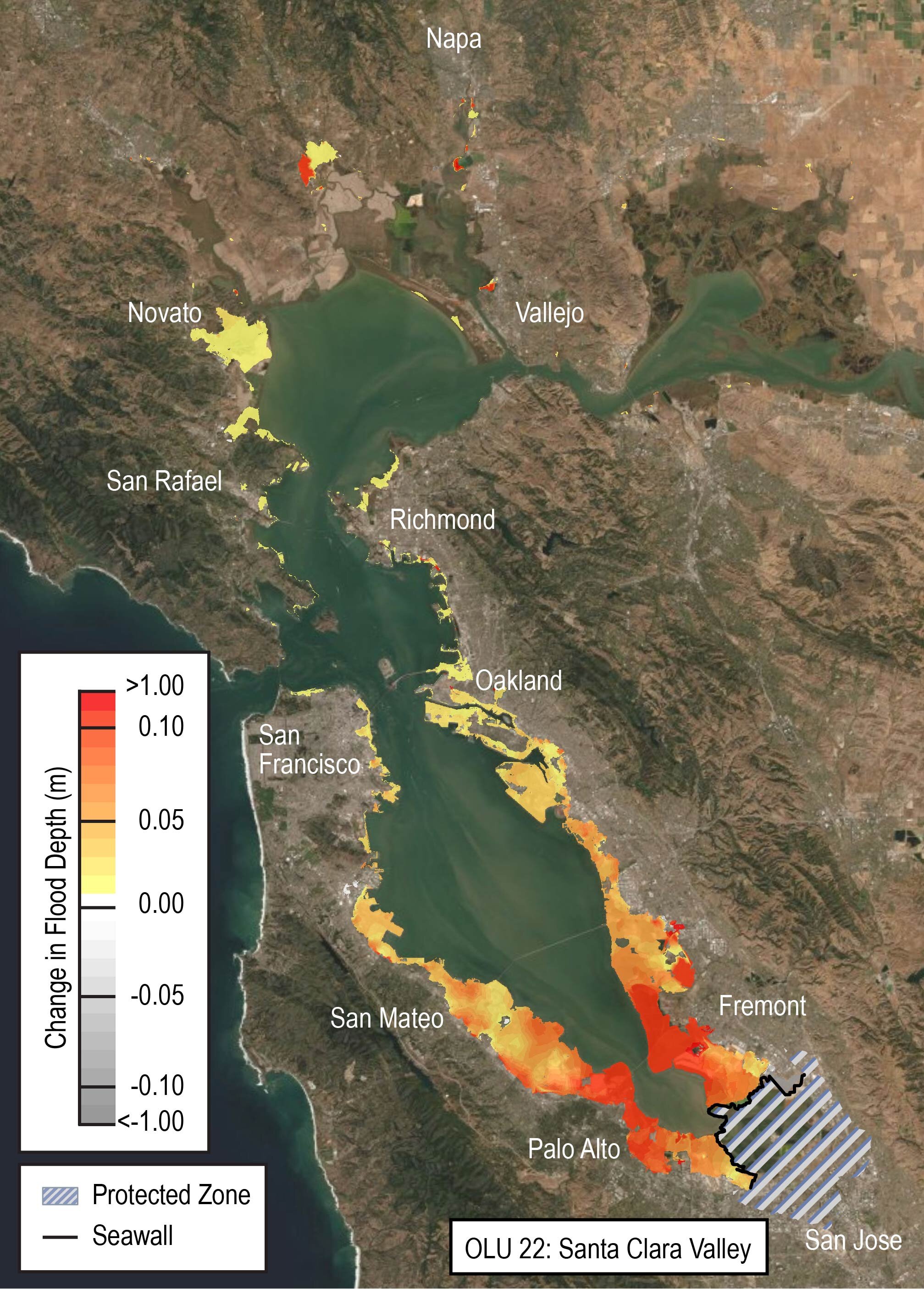Communities trying to fight sea-level rise could inadvertently make flooding worse for their neighbors, according to a new study from the Stanford Natural Capital Project.
The research, published in Proceedings of the National Academy of Sciences, shows how seawalls constructed along the San Francisco Bay shoreline could increase flooding and incur hundreds of millions of dollars in damages for communities throughout the region. The researchers emphasize how non-traditional approaches, like choosing to flood certain areas of land rather than build walls, are smarter, more sustainable solutions for the Bay Area and similar coastal bay communities.
“It’s not practical to keep building taller and taller seawalls to hold back the ocean,” said Anne Guerry, chief strategy officer and lead scientist at the Stanford Natural Capital Project and senior author on the paper. “Our goal was to show how the threat of sea-level rise is interconnected with the whole social-ecological system of the Bay Area. Communities need to coordinate their approaches to sea-level rise adaptation so we can find solutions that are best for the whole bay.”
By 2100, sea levels are projected to rise by almost seven feet in the Bay Area. Millions of people live and work in buildings that are collectively worth hundreds of billions of dollars within the Bay Area’s projected sea-level rise zone. As water levels increase, governments are looking for ways to protect their communities and economies.
Following the flow
The researchers used complex mathematical models to map how floodwaters—and the economic damages related to floods—would flow depending on where new seawalls were built. They found that blocking certain areas of the bay’s shoreline would be particularly damaging to communities throughout the region. For instance, if a seawall were built along the San Jose shoreline, communities throughout the bay, from Redwood City to Napa and Solano counties, would face an additional $723 million in flood damage costs after just one high tide, according to the models.
Damages to buildings and homes aren’t the only losses that could result from walling shorelines—it also can cut off habitat for important bird and fish species, limit the natural area available to store carbon and create water quality issues by destroying wetlands that naturally provide water treatment.
“You may be protecting your immediate community, but you may be creating serious costs and damages for your neighbors,” said Robert Griffin, an economist at the Natural Capital Project and co-author on the paper. “When it comes to current sea-level rise planning, there’s some incomplete cost-benefit accounting going on.”
Guiding the flood
The researchers identified places where Bay Area communities could strategically choose to guide floodwaters, rather than holding them back with walls. These strategic flood areas would act as overflow zones, absorbing the increased water and avoiding damage to communities.
One example is along the Napa-Sonoma shoreline, where Highway 37 is under threat of impending sea-level rise. Decision-makers are trying to decide how to adapt the road to prevent flooding in the future: either by building a taller embankment to raise the road or by rebuilding it as a causeway that allows water to flow between the bay and marshlands on the other side. The researchers modeled what would happen if the Napa-Sonoma shoreline were blocked by a concrete embankment and found that it would worsen flooding for almost all the Bay Area communities studied, from Martinez to San Jose. Building a causeway, on the other hand, would provide a natural absorption area for extra water to flow.
A Bay-wide strategy
“It’s critical to consider the regional impacts of local actions,” said Michelle Hummel, assistant professor at the University of Texas at Arlington and lead author on the paper. “Studies like ours can identify actions that will have large impacts, either positive or negative, on the rest of the bay and help to inform decisions about how to manage the shoreline.”
Not every city or county has a landscape suitable for strategic flooding, which requires wide plains or valleys where water will naturally flow. Therefore, the researchers say it’s crucial that Bay Area communities work together to identify the places where nature-based solutions like flooding make the most sense.
The researchers also looked at demographic information in their models to better understand who would be affected by possible strategic flooding plans. They say avoiding adaptation plans that add more pressure to poor or otherwise overburdened communities—by forcing them to move or creating increased economic stress—is key.
To understand the broader impacts of climate resilience decisions, including investments in nature, the researchers plan to model how sea-level rise adaptation strategies are connected with infrastructure, employment, community dynamics and more.
“Our plans should be as interconnected as our ecosystems,” said Guerry.
Coastal flooding increases Bay Area traffic delays and accidents
Michelle A. Hummel el al., “Economic evaluation of sea-level rise adaptation strongly influenced by hydrodynamic feedbacks,” PNAS (2021). www.pnas.org/cgi/doi/10.1073/pnas.2025961118
Citation:
Researchers map how sea-level rise adaptation strategies impact economies and floodwaters (2021, July 12)
retrieved 12 July 2021
from https://phys.org/news/2021-07-sea-level-strategies-impact-economies-floodwaters.html
This document is subject to copyright. Apart from any fair dealing for the purpose of private study or research, no
part may be reproduced without the written permission. The content is provided for information purposes only.
For all the latest Science News Click Here
For the latest news and updates, follow us on Google News.

